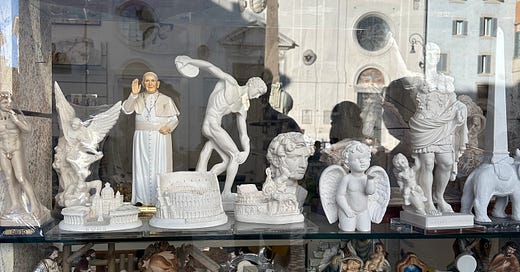Yesterday I took folk on a wander through the Field of Mars under the crisp blue skies of a warm early November. We met by the Pulcino della Minerva, the splendidly esoteric elephant sculpture designed by Bernini to carry a sixth century BCE Egyptian obelisk. Carved for the Pharaoh Apries and erected at Sais the obelisk was brought to Rome by Diocletian to adorn the Iseum, the temple dedicated to the Egyptian goddess Isis in the Campus Martium. In the seventeenth century it was found, languishing in the mud and rubble of a millennium, dusted off, erected for Alexander VII, and topped with a cross for good measure. It is a synecdoche of Rome’s soup of centuries: the city of the emperors and that of the popes coexisting in a sort of temporal hologram exuding triumph.
As we introduced ourselves, a display in the window of a souvenir shop caught my eye and I decided to begin our tour using this gloriously kitsch and profoundly Roman visual aid.
The models of the Augustus of Prima Porta and of Pope Francis, both holders of the title Pontifex Maximus, offered a couple of points of departure for our exploration of the fabulously dense Campo Marzio. It was under Augustus that the area was first incorporated into the expanded city limits. A boom in the city’s population was facilitated by his conquest of Egypt, the harnessing of the agricultural wealth of the fertile valley of the Nile, and the end of civil war. Rome is believed to have reached a population of a million people, very probably the biggest city the world had ever seen. Shown in the slightly shonky plaster model in the window as imperator, commander of the army, Augustus is supported by Cupid in allusion to Venus, goddess of love and mother of the Trojan hero Aeneas who Augustus claimed as his ancestor. The barefoot statue emphasises the divine nature of the rule of Rome’s first emperor, a destiny which would be reinforced by his establishment as Pontifex Maximus, high priest of the Roman religion.
The putto to the left of Augustus is an iteration of Cupid, a reminder of the iconographic segue from the Roman pagan religion to the Christian city. The religious beliefs are, of course, entirely different but the formal arrangement of the Roman Church is, after all, extremely Roman. Four centuries after Augustus was granted the ancient title of Pontifex Maximus, a fusion of the temporal and spiritual realms unthinkable during the Roman Republic, Emperor Theodosius declared Rome a Christian Empire. In 380 Theodosius issued the Edict of Thessaloniki and gave the role of Pontifex Maximus (Supreme Pontiff), its origins lost in the misty realm of legend of the kingdom founded by Romulus, to the leader of the Roman Christians.
What had for the Romans once been a mysterious, impudent, religious cult emerging from the East of Empire was now the religion of state. Over one and a half millennia later, as the first quarter of the twenty-first century draws to a close, the Pontifex Maximus, a title already ancient when granted to Augustus, is an elderly gentleman from Argentina. The image of Pope Francis waves benevolently from the souvenir shop window between the Colosseum and St Peter’s, between a scrawny discobolus and a shrink-wrapped Archangel Michael, as the obelisk once made for an Egyptian pharaoh and set atop a Baroque elephant is reflected. It was a super start to an afternoon exploring temples and churches amid cobbled streets and crisp chiaroscuro.
Saluti from Rome, Agnes





Loved reading about the 'Field of Mars'
Fabulous photo and commentary.